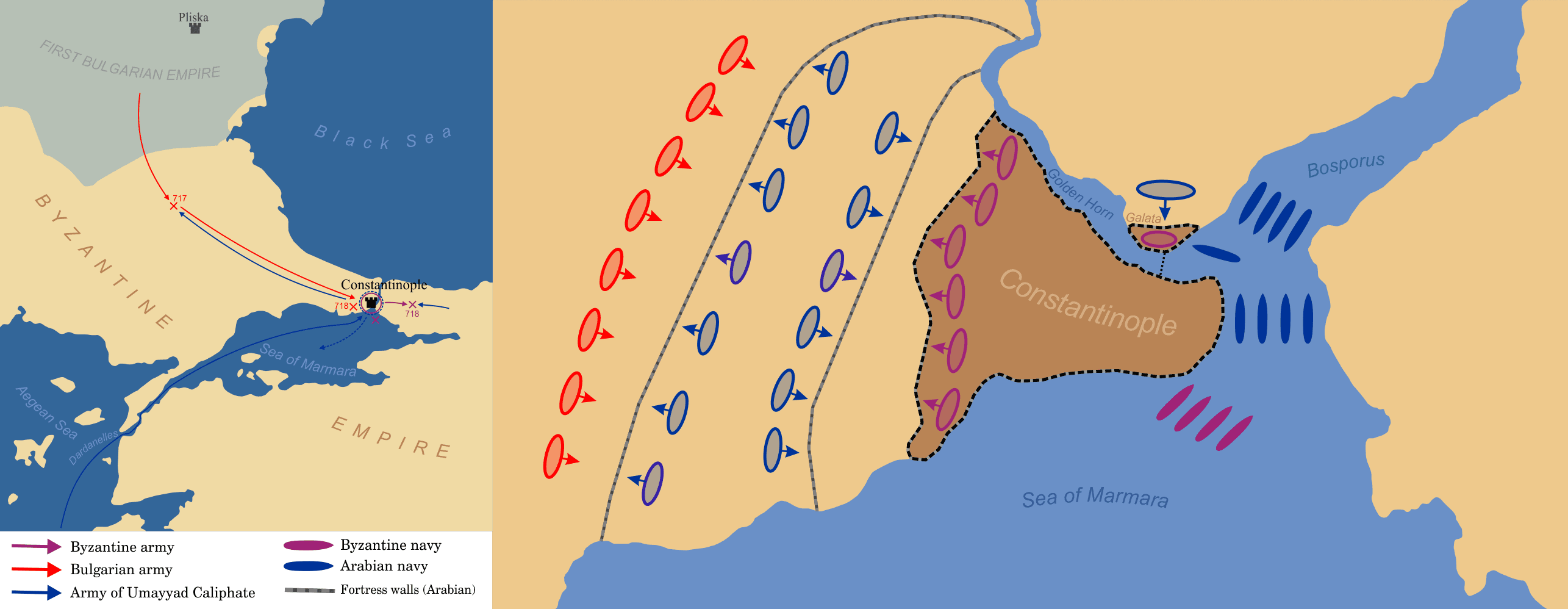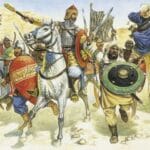The Siege of Constantinople (717): When the City That Never Sleeps Stood Strong
Picture this: It’s 717 AD. The Umayyad Caliphate, a formidable empire stretching across the Middle East and North Africa, sets its sights on the crown jewel of the Byzantine Empire – Constantinople. This wasn’t just any city; it was a melting pot of cultures, a vibrant hub of trade, and a symbol of Christian strength. The fate of empires hung precariously in the balance.
Leading the charge was Caliph Suleiman, determined to breach the city walls and plant the flag of the Umayyad Caliphate. His strategy? A two-pronged attack: a massive land force to besiege the city and a fearsome navy to cut off vital supplies and reinforcements. On paper, it seemed like an unstoppable plan.
But Constantinople wasn’t called “the city that never sleeps” for nothing. Emperor Leo III, a shrewd and resolute leader, rallied his people, inspiring them to fight tooth and nail for their home. The city walls, already formidable, bristled with defenders, their courage bolstered by the knowledge that they were protecting not just their homes but their very way of life.
And then there was the secret weapon: Greek fire. This mysterious incendiary weapon, capable of burning even on water, struck terror into the hearts of the Arab navy. Imagine their horror as their ships, trapped in the narrow straits, were engulfed in flames! This devastating advantage turned the tide of the naval battle decisively in favor of the Byzantines.
The siege dragged on relentlessly for over a year. The Umayyad forces, relentless in their assault, tried every tactic in the book: towering siege towers, powerful catapults, even attempting to bribe their way into the impenetrable city. But the Byzantines held firm, their spirit unbroken. The winter of 717 proved particularly brutal for the besiegers, with dwindling supplies and a relentless enemy at their doorstep.
Finally, in the summer of 718, with their forces depleted and morale shattered, the Umayyads admitted defeat and retreated. The victory sent shockwaves throughout the known world. Constantinople had withstood the might of one of the most powerful empires of its age.
The impact of this victory echoed through the centuries. It not only saved the Byzantine Empire from imminent collapse but also acted as a crucial bulwark against the further expansion of the Umayyad Caliphate into Europe. It was a testament to the unwavering courage of the Byzantine people, the strategic brilliance of their leaders, and the critical importance of innovation in warfare. The Siege of Constantinople (717) stands as a pivotal moment in history, a resounding reminder that even against overwhelming odds, human resilience and unwavering determination can prevail.
What Led to the Siege of Constantinople in 717?
The seeds of the 717 siege were sown decades earlier. You see, the first Arab siege of Constantinople back in 674, though unsuccessful, had left the Umayyad Caliphate hungry for conquest. Their desire to expand their empire remained undeterred. After a period of relative peace, they were back, this time under the rule of the ambitious Caliph Suleiman.
Adding fuel to the fire were the actions of Emperor Justinian II, then ruler of Constantinople. Known for his aggressive policies, Justinian II’s actions antagonized the Umayyads, creating a palpable tension between the two empires. It was a powder keg waiting for a spark.
However, the Umayyad Caliphate was not a monolithic entity. Internally, they were grappling with the turmoil of the Second Muslim Civil War. Conflicts and rivalries threatened to tear them apart, weakening their ability to sustain a prolonged and large-scale assault on Constantinople.
Meanwhile, Constantinople had learned valuable lessons from the first siege. The city itself was a fortress, its massive, thick walls practically insurmountable. Adding to their defenses was the Byzantines’ secret weapon – “Greek Fire,” a terrifying incendiary weapon that could burn even on water. Emperor Leo III, understanding the importance of a strong defense, ensured that these defenses were in peak condition.
The stakes were incredibly high. Constantinople was not merely the capital of the Byzantine Empire; it was their economic and cultural heart, a vital trading hub, and the gateway between Asia and Europe. Conquering Constantinople would be a devastating blow to the Byzantines, opening up Europe to further Umayyad expansion.
The Umayyad campaign was spearheaded by the general Maslama. But even within their ranks, unity was a challenge. Jealousies and power struggles plagued their leadership. This internal friction hampered effective command, leading to delays, strategic disagreements, and ultimately, a weakening of the siege effort.
The Siege of Constantinople 717: Key Players & Strategies
The year 717 AD witnessed a clash of civilizations. The Umayyad Caliphate, at the zenith of its power, sought to capture a prize that could reshape the world: Constantinople, the heart of the Byzantine Empire. This wasn’t just another battle for territory; it was a struggle for dominance, a confrontation that would determine the fate of empires and redraw the map of Europe.
Leading the Umayyad charge was the ambitious Caliph Suleiman. His objective went beyond mere conquest; he sought to make a statement, to extinguish the Byzantine flame and claim the Eastern Mediterranean as their own. They assembled a colossal army and navy, meticulously planning to crush Constantinople under their might.
But Constantinople was a city prepared for war. Its towering walls, symbols of Byzantine resilience, stood ready. At the helm of the city’s defense was a man who would become a legend: Emperor Leo III. He understood the gravity of the threat and the need to fight tooth and nail for every inch of his city.
Leo III was not just a figurehead; he was a brilliant strategist. He recognized that Constantinople’s survival hinged not just on its impressive fortifications, but also on their ability to outmaneuver their enemies. He rallied his troops, strengthened the city’s defenses, and prepared for a siege unlike any other.
The Byzantines had a secret weapon in their arsenal: Greek Fire, a fearsome weapon that could burn on water. This liquid inferno, launched from Byzantine ships, transformed the sea itself into a battleground. The sight of Arab ships engulfed in flames, trapped in the narrow straits, instilled fear and chaos within their ranks.
The siege raged on for months. The Umayyads relentlessly attacked the city walls, but Constantinople refused to yield. The city’s defenders, fueled by their emperor’s leadership and the conviction that they were defending not just their homes but the very soul of their civilization, fought with unwavering resolve.
By August 718, the tide had turned. The Umayyad forces, battered by relentless Byzantine attacks, crippled by dwindling supplies, and ravaged by the unforgiving grip of winter, were forced to concede defeat and retreat. Against all odds, Constantinople had triumphed.
The victory resonated far beyond the city walls. It marked a turning point in history, halting the westward expansion of the Umayyad Caliphate and securing the Byzantine Empire’s position as a dominant power in the region. It became a testament to the strategic brilliance of Emperor Leo III, the unwavering courage of the Byzantine people, and the pivotal role of innovative technology like Greek fire in shaping the outcome of wars. The Siege of Constantinople 717 wasn’t just a battle; it was a clash of civilizations, a struggle for survival, and a story of human courage and resilience etched into the very fabric of history.
How Did Greek Fire Impact the Siege of Constantinople 717?
Constantinople’s defenses were legendary, but the Arab siege of 717-718 AD put them to the ultimate test. The Arabs, however, had not accounted for the Byzantine Empire’s secret weapon: Greek fire. This mysterious incendiary weapon played a crucial role in repelling the invaders and securing a Byzantine victory. This wasn’t just a victory for Constantinople, it was a turning point in history, ensuring the survival of the Byzantine Empire and altering the balance of power in the region. Emperor Leo III, a leader of great strategic mind, expertly employed Greek fire to its full potential, and that, combined with Constantinople’s already formidable defenses, paved the way to victory.
Think of it Like This: Greek Fire at Sea
Imagine battling a fire that intensifies with every bucket of water thrown upon it. That was the terrifying reality faced by the Arab fleet when confronted with Greek fire. This mysterious incendiary weapon was unlike anything they had encountered before. To this day, historians are still not entirely sure of its exact composition, but imagine a mixture of highly flammable substances like petroleum, sulfur, quicklime, potentially combined with pine resin and niter. The result was a substance that ignited upon contact and was virtually impossible to extinguish with water.
The Byzantines deployed this deadly concoction from tubes called “siphons” mounted on their ships. When Greek fire struck an Arab ship, the results were instantaneous and devastating. The unlucky vessel would be engulfed in an inferno, its crew left with little hope of survival. The Arab navy had no defense against this terrifying weapon, and it wreaked havoc on their fleet. Numerous ships were lost, their hopes of a successful naval blockade going up in smoke along with their vessels. This allowed Constantinople to remain supplied and its defenders reinforced, a crucial factor in their ability to withstand the siege.
And That’s Not All: Greek Fire on Land
Greek fire wasn’t just a naval weapon; the Byzantines found ingenious ways to utilize it on land as well. They launched it from catapults and even incorporated it into their siege towers. The chaos and terror this inflicted upon the Arab troops is unimaginable. Maintaining a siege when faced with Greek fire raining down from above was a nightmare. Formations scattered, siege weapons were destroyed, and the ability to regroup or launch effective attacks was severely hampered. This added pressure on the already beleaguered Arab camps, contributing to the spread of disease and making it incredibly difficult to keep the troops fed and supplied.
Walls, Tactics, and a Smart Emperor
It wasn’t just the possession of Greek fire that led to Byzantine victory; Emperor Leo III was a masterful strategist who knew how to utilize it effectively. Combined with Constantinople’s already impressive defenses, like the iconic Theodosian Walls – massive fortifications that had been strengthened and expanded over centuries – it’s clear why the Arabs never stood a chance. These walls stood as an impenetrable shield, rendering Arab siege towers and battering rams useless. In addition to these defenses, the Byzantines possessed their own skilled navy, which they used to effectively block the Bosporus Strait. This vital waterway was crucial for the Arabs, and by controlling it, the Byzantines prevented them from bringing in reinforcements or completely surrounding their city.
The Tables Turn: Why the Siege Failed
The Arab siege, ultimately, was a complete disaster. A confluence of key factors led to their defeat: Greek fire, a weapon that terrified and demoralized the Arab troops while crippling their fleet; Constantinople’s incredibly strong defenses, which proved impossible to breach; and Emperor Leo III, whose clever tactics and strategic use of Greek fire gave the Byzantines an insurmountable advantage. Weakened by disease, ravaged by famine, and demoralized by their losses, the Arabs were left with no choice but to retreat. It was a turning point in history, one that ensured the Byzantine Empire lived to fight another day and spared Europe from a major Arab advance.
The Takeaways
- Greek Fire: A Game-Changer: This secret and terrifying weapon tipped the scales decisively in favor of the Byzantines. The Arabs simply had no answer for it.
- Strategic Brilliance: It wasn’t just the weapon itself, but how and where it was used. Leo III’s tactical brilliance proved crucial in securing victory.
- Impregnable Defenses: Constantinople’s defenses were already legendary, but Greek fire made them virtually invincible.
- Ripple Effects: The failed siege had far-reaching consequences, saving the Byzantine Empire and significantly altering the course of history.
Discover the fascinating history of the Arab Byzantine wars that reshaped the political and religious landscape of the Middle East.
Key Points of the Siege of Constantinople (717):
- Attackers: Umayyad Caliphate led by Caliph Suleiman
- Target: Constantinople, the capital of the Byzantine Empire
- Siege Strategy: Two-pronged attack with land forces and a navy
- Defenders: Byzantine Empire led by Emperor Leo III
- Fortifications: Fortified city walls with Greek fire (incendiary weapon)
- Siege Duration: Over a year
- Siege Tactics: Siege towers, catapults, bribery attempts
- Outcome: Byzantine victory due to strong defense, Greek fire, and resilience
- Impact: Preservation of the Byzantine Empire, deterrence of Umayyad Caliphate’s expansion into Europe, demonstration of the importance of courage, strategy, and innovation in warfare.
Why the Siege of Constantinople in 717 Mattered:
- A Clash of Empires: The Second Arab Siege of Constantinople (717-718) represented a culmination of decades of territorial expansion by the Arabs and a direct challenge to the dominance of the Byzantine Empire.
- Defeat Against the Odds: Despite meticulous planning and a massive force, the Arabs were defeated due to the strength of Byzantine defenses, the devastating impact of Greek fire, and internal divisions within the Umayyad Caliphate.
- Turning the Tide: This failure significantly weakened the Umayyad Caliphate and marked a turning point in the Arab-Byzantine conflict. Constantinople, a strategically vital city, was preserved.
- Enduring Lessons: The siege is a testament to the resilience and strategic prowess of the Byzantine Empire and highlights the complex relationship between the Arab and Byzantine empires during the early Middle Ages.
A Closer Look at the Events:
Background:
- Following the First Arab Siege of Constantinople (674-678), a period of uneasy peace prevailed.
- The Umayyad Caliphate found itself embroiled in the Second Muslim Civil War, which allowed the Byzantine Empire to consolidate its power in the East.
- Hostilities resumed in 692 under Emperor Justinian II, leading to Arab victories and gradual encroachment upon Byzantine territories.
The Siege Begins:
- Maslama, a skilled Arab general, assembled a massive army and a formidable fleet for the siege of Constantinople.
- In 717, the Arabs crossed the Hellespont into Thrace and marched on Constantinople, marking the start of the siege.
Forces in Play:
- The Byzantine defense system relied on layers of thick city walls, the devastating power of Greek Fire, and a highly disciplined and well-trained army.
- The Arabs, in turn, brought with them siege towers, catapults, and a large fleet to support their assault and cut off Constantinople from vital supplies.
Why the Siege Failed:
- The Byzantine defenses proved to be a formidable obstacle that the Arab army could not overcome.
- Greek Fire wreaked havoc on the Arab fleet, repelling their naval assaults and preventing a successful blockade of the city.
- Internal divisions and power struggles within the Umayyad Caliphate significantly hampered their ability to effectively conduct the siege.
The Aftermath:
- The failure of the siege was a major setback for the Umayyad Caliphate, halting their expansion in the region and weakening their grip on power.
- It signaled the enduring strength and resilience of the Byzantine Empire, capable of defending its territory against even the most determined enemies.
- The conflict between the Arabs and Byzantines continued for centuries, shaping the political and religious landscape of the Mediterranean.
Unveiling Deeper Insights:
- Technological Advancements: Explore the role of technological innovations, particularly Greek fire, in shaping the outcome of the siege and impacting medieval warfare.
- Internal Politics: Delve into the political landscape of the Umayyad Caliphate and analyze how internal strife and rivalries influenced their strategic decisions and ultimately contributed to their defeat.
- Shifting Power Dynamics: Examine the lasting impact of the siege on the balance of power between the Arab and Byzantine empires and trace its influence on the geopolitical landscape of the region.
The 717-718 siege of Constantinople wasn’t just a battle; it was a clash of civilizations. The courage, resilience, and strategic ingenuity of the Byzantines, however, ensured that their empire would endure, forever shaping the course of history.
- Unlock Water’s Symbolism: A Cross-Cultural Exploration - April 20, 2025
- Identify Black and White Snakes: Venomous or Harmless? - April 20, 2025
- Unlocking Potential: Origins High School’s NYC Story - April 20, 2025















